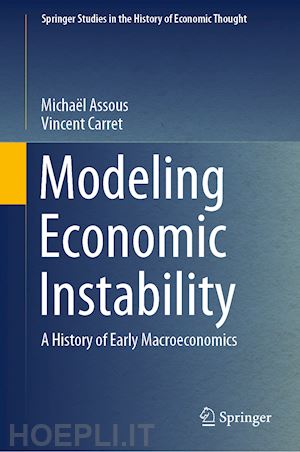
Questo prodotto usufruisce delle SPEDIZIONI GRATIS
selezionando l'opzione Corriere Veloce in fase di ordine.
Pagabile anche con Carta della cultura giovani e del merito, 18App Bonus Cultura e Carta del Docente
This book offers a fresh perspective on the early history of macroeconomics, by examining the macro-dynamic models developed from the late 1920s to the late 1940s, and their treatment of economic instability. It first explores the differences and similarities between the early mathematical business cycle models developed by Ragnar Frisch, Michal Kalecki, Jan Tinbergen and others, which were presented at meetings of the Econometric Society and discussed in private correspondence. By doing so, it demonstrates the diversity of models representing economic phenomena and especially economic crises and instability. Jan Tinbergen emerged as one of the most original and pivotal economists of this period, before becoming a leader of the macro-econometric movement, a role for which he is better known. His emphasis on economic policy was later mirrored in the United States in Paul Samuelson’s early work on business cycles analysis, which, drawing on Alvin Hansen, aimed at interpreting the 1937-1938 recession. The authors then show that the subsequent shift in Samuelson's approach, from the study of business cycle trajectories to the comparison of equilibrium points, provided a response to the econometricians' critique of early Keynesian models. In the early 1940s, Samuelson was able to link together the tools that had been developed by the econometricians and the economic content that was at the heart of the so-called Keynesian revolution. The problem then shifted from business cycle trajectories to the disequilibrium between economic aggregates, and the issues raised by the global stability of full employment equilibrium. This was addressed by Oskar Lange, who presented an analysis of market coordination failures, and Lawrence Klein, Samuelson's first PhD student, who pursued empirical work in this direction.
The book highlights the various visions and approaches that were embedded in these macro-dynamic models, and that their originality is of interest to today's model builders as well as to students and anyone interested in how new economic ideas come to be developed.
Michaël Assous is a Full Professor of Economics at the Université Lumière Lyon 2, France. Since 2017, Assous has coordinated the research branch focusing on the history of economics at Triangle, a center whose mission is to promote and support research and teaching on the history of economics in France. His principal research interests lie in the history of macroeconomics. His earlier work, much of which focused on the Polish economist Michal Kalecki, dealt with the analytical components of economics. Since his fellowship year at the HOPE Center in 2012–2013, Assous has drawn on the rich resources of the Economists’ Papers Project and used archival material in his research projects on instability and the recent history of macroeconomics, focusing on Robert Solow, Franco Modigliani, Oskar Lange and Paul Samuelson. In 2012, he was awarded the ESHET (European Society of the History of Economic Thought) Young Researcher Award.
Vincent Carret is a Ph.D. student at the Université Lumière Lyon 2, where he is working on the history of macroeconomic thought. His thesis focuses on different approaches to stability in models from the interwar to the postwar period. One of his objective is to render the models from that time more accessible through the use of web-based simulations. He has already published papers in the Revue d’Économie Politique, (in collaboration with Michaël Assous, Muriel Dal Pont Legrand and Olivier Bruno), the European Journal of the History of Economic Thought (in collaboration with Michaël Assous) and in the Journal of the History of Economic Thought. Vincent Carret is a visiting researcher at the HOPE Center at Duke University for the year 2021–2022.











Il sito utilizza cookie ed altri strumenti di tracciamento che raccolgono informazioni dal dispositivo dell’utente. Oltre ai cookie tecnici ed analitici aggregati, strettamente necessari per il funzionamento di questo sito web, previo consenso dell’utente possono essere installati cookie di profilazione e marketing e cookie dei social media. Cliccando su “Accetto tutti i cookie” saranno attivate tutte le categorie di cookie. Per accettare solo deterninate categorie di cookie, cliccare invece su “Impostazioni cookie”. Chiudendo il banner o continuando a navigare saranno installati solo cookie tecnici. Per maggiori dettagli, consultare la Cookie Policy.